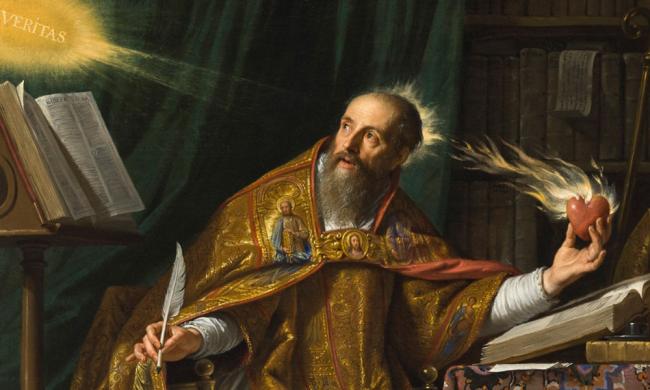By Lawrence Feingold

St. Augustine’s theology of the Eucharist stresses its proper effect, which is the unity of the Mystical Body. It has this effect of binding together the Mystical Body of Christ precisely because the members of the Church receive the real Body and Blood of Christ. In other words, the charity that binds the Church together is the proper effect of receiving the Body and Blood of Christ. The Eucharist can build up the Body of Christ in charity (later to be called the res tantum) only because it is itself the Body of Christ sacramentally present (res et sacramentum). In this way St. Augustine is also stressing the realism of Christ’s Body and Blood in the Eucharist, present under the sacramental species.
In Sermon 227 to the neophytes on Easter, St. Augustine says that the visible bread and wine on the altar, “sanctified by the word of God,” is His Body and Blood. Through devoutly receiving that Body and that Blood that was shed for us, we become that Body, which means that we are joined in the close union of the Mystical Body.
St. Augustine’s Eucharistic realism can be seen in his affirmation that what we receive in Communion is the same Body of Christ that hung on the Cross, from which we are fed. In a sermon to the neophytes, he says: “Recognize in the bread what hung on the cross, and in the cup what flowed from his side.”
St. Augustine’s insistence on worship of the Eucharist before receiving Communion shows that he clearly acknowledges the substantial presence of Christ’s Body and Blood in the Eucharist. The Eucharist is worthy of worship only because it contains the substantial presence of the humanity of the Word. This is a good example of how liturgical practice—in this case, the adoration of the consecrated host in the Eucharistic liturgy—manifests doctrine.
St. Augustine stresses the identity of the Priest and the Victim in the Eucharist at the Last Supper. In a commentary on Psalm 33, he speaks of Christ holding His own Body in His hands at the Last Supper: “Christ was being carried in his own hands when he handed over his body, saying, ‘This is my body’; for he was holding that very body in his hands as he spoke.” In De Trinitate, he speaks similarly of the Mass as a sacrifice in which Christ is Priest and Victim: “And what could be so acceptably offered and received, as the flesh of our sacrifice, made the body of our priest?”
St. Augustine also emphasizes the sacrificial nature of the Eucharist in his sermons to the neophytes on Easter day. In Sermon 228, he speaks of the Eucharist as the true sacrificial offering of Christ’s Body and Blood that was prefigured in all the sacrifices of the Old Covenant. The Eucharist alone is the sacrifice of the “body and blood of the priest himself.”
St. Augustine also stresses that the sacrifice of the Mass involves, together with the sacrifice of Christ, the sacrifice of the faithful of themselves. In Sermon 227 for the neophytes on Easter, he says:
Then, after the consecration of the Holy Sacrifice of God, because he wished us also to be his sacrifice, a fact which was made clear when the Holy Sacrifice was first instituted, and because that Sacrifice is a sign of what we are, behold, when the Sacrifice is finished, we say the Lord’s Prayer.
St. Augustine so strongly identifies the Eucharistic Body of Christ and the ecclesial Body of Christ that, if the one is offered, so must be the other. The sacrifice of the Head, made present on the altar, demands the interior self-sacrifice of the members who gather to offer the Holy Mass.
Dr. Lawrence Feingold is Associate Professor of Theology and Philosophy at Kenrick-Glennon Seminary in St. Louis. He is the author of The Eucharist: Mystery of Presence, Sacrifice, and Communion, which offers a comprehensive study of the mystery of the Eucharist.